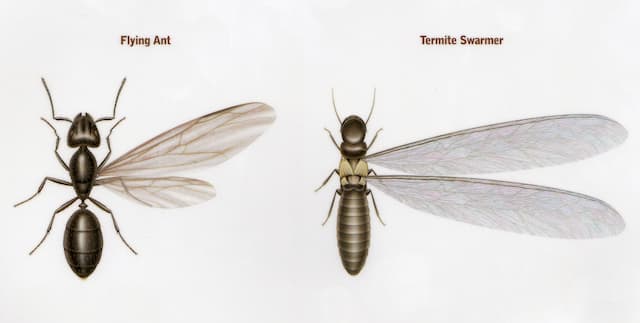Carpenter ants are insects found almost everywhere in the world including Southern Ontario and Toronto. They are predators of other insects, scavengers of organic debris, and they use wood to build nests, both in fallen trees and wooden structures. They are similar to termites in many ways however, they are different in the sense that termites feed on wood, while carpenter ants just use it to build tunnels. When endowed with wings during mating flight, you will not easily find the differences between carpenter ants and termites.
Flying ant to the left, and termite to the right.
Carpenters ants pose the biggest problem to control. They are not hard to kill but it is hard to locate their nest, as they have a high potential of travelling a long distance and hiding in obscure places. They do not feed on wood but merely excavate large, intricate galleries in it for the purpose of nesting. You will know that they have infested a place when you see small piles of sawdust debris that has fallen around wooden structures and or furniture. The dust has been pushed out by worker ants in an effort to keep living areas free of wood debris during their excavating activities.
Morphologically, the differences between carpenter ants and termites are as follows. Carpenter ants have a thin waist between the thorax and abdomen, whereas termites have thorax and abdomen joined broadly and closely across the adjusted surfaces. Carpenter ants have antennae that are elbowed at the middle, while termites have antennae with uniformly sized segments that resemble a string of beads.
Termites have four wings which all have the same shape and size and while carpenter ants also have four wings, their front wings are larger and have a different shape than the rear wings.
You will discover the carpenter ants by the presence of ant forages inside the dwelling, the presence of swarmers with wings, suddenly emerging on a spring day, rustling sounds within woods or walls, caused by ants engaged in colony activities, and the appearance of small piles or layers of sawdust-like frass on floors, window ledges, or furniture.
If you are having a problem with ants visit our ant control page.

